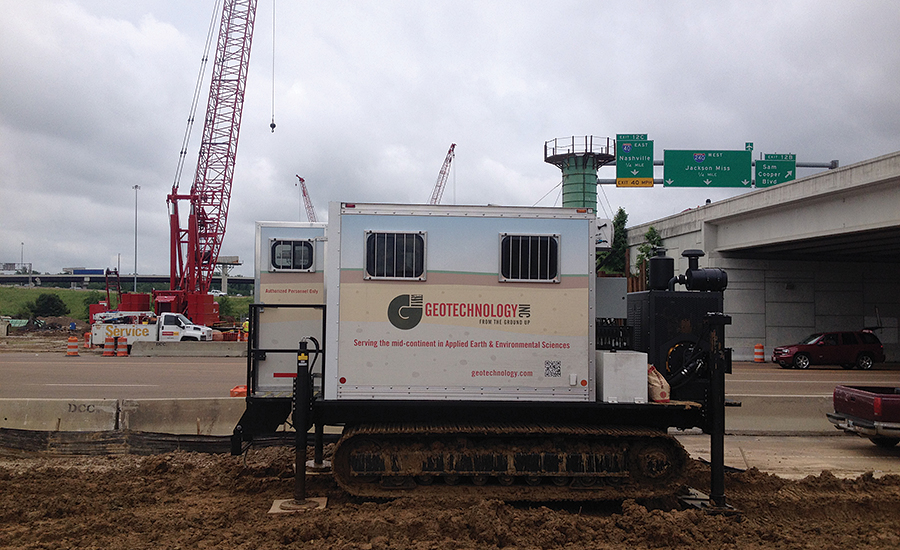Engineer Talks About Uses, Benefits of Cone Penetration Testing




What Is CPT and How Is It Used?
Cone penetration testing (CPT) provides a detailed in situ testing method to map soil stratigraphy and estimate many fundamental geotechnical engineering properties of softer, sensitive soils.
With CPT, the cone is pushed at a controlled rate into the soil and load cells within the cone record data that is transmitted to the software in the cab of our rig. This generates a near-continuous record of data that can reveal thin layers of dissimilar materials, which could be missed with conventional drilling and interval sampling. These thin layers can have a significant impact in geotechnical engineering aspects of a project.
Our cone is a seismic piezocone so it records the typical tip pressure, sleeve pressure and pore water pressure. For the seismic portion, we have a tri-axial geophone setup, so there are three geophones oriented on three separate axes.
CPT is an alternative method of data collection to conventional drilling and interval sampling. Conventional drilling and interval sampling are still very valid methods of data collection, especially in areas where soils are hard or gravelly (places CPT can’t push).
What Makes CPT Better?
It’s not that CPT is better. It’s a different way to collect information that works more efficiently on some sites. Depending on the site, time frame and other factors, CPT can be a more cost effective method for projects in a number of ways. CPT can also collect in situ data in soft sensitive and difficult to sample soils.
First is timing. Typically CPT is faster, especially in deeper holes, than conventional drilling. CPT really shines in applications where seismic data also needs to be collected. With conventional drilling and interval sampling, a team is deployed to a site, they have to pre-drill a hole and get the soil data, then grout and case the hole and come back a day or two later to perform the actual test. In pushing CPT, all of the necessary data can be collected in one sounding in a couple of hours rather than days.
Second, in conventional methods, i.e. downhole seismic, the geophone is sent into the pre-drilled hole and the source wave has to go through the soil, grout and casing, and then is registered by the geophone. Each change in medium can cause “noise” in the data, making it more difficult to analyze. The CPT cone is in direct contact with the soil, so there is no medium change for the source wave to pass through. This results in a cleaner signal that is typically easier to interpret.
If testing needs to be performed on an environmentally impacted site there is an additional advantage. CPT does not generate cuttings. Once a sounding has been completed, there are no contaminated soils to deal with at the surface. Decontamination is also simpler as you just need to clean the rods, as opposed to the large augers used in conventional drilling.
How Does Geotechnology Use CPT?
In the beginning when we had the CPT equipment but no rig we would use it primarily in the St. Louis area, occasionally around Kansas City. In 2013 we purchased our 20-ton track mounted CPT rig and have since provided these services all over the states of Tennessee, Missouri, Kansas, Arkansas, Mississippi and Kentucky. Our Memphis office has been using shear wave velocities to help refine site specific seismic studies for a long time. Using our CPT rig to gather seismic data at the same time they are on site collecting soil data has provided savings in both time and money for our clients.
We recently used CPT to provide data for a levee recertification program in Kansas. We were able to run the rig across the levees and push the soundings in inclement weather, completing 33 soundings in approximately 11 days across approximately 20 miles of levee.
In Memphis we used it in a forensic analysis application rather than pre-design. That project had some driven concrete piles that didn’t reach their target depth and were refusing right above a liquefiable layer. The idea was to drive through the liquefiable layer and densify it to remediate the liquefaction potential. We performed some CPT adjacent to the piles and in intervals away from the piles. Based on the data collected, we were able to determine that the piles had improved the ground at the lengths they were currently seated. The improvement was enough to reduce the liquefaction potential, so additional remediation was not necessary.
We are currently working on project in Kansas City where they are relocating a pipe at a depth of 100 feet. We are collecting shear wave velocity data to get some of the values needed for the hydrofracture risk analysis.
Brian Sanders, PE, is senior staff engineer for Geotechnology Inc.
Looking for a reprint of this article?
From high-res PDFs to custom plaques, order your copy today!









